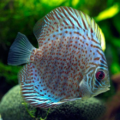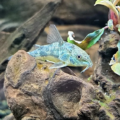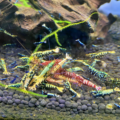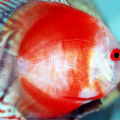This aquarium guide will cover everything you need to know about Pigeon Blood Discus fish from their intricate fish care to their ideal tankmates, feeding tips, if breeding is simple, and much more. Beginners and seasoned aquarists are welcome to use this guide as their go-to resource for keeping these vibrant species thriving and healthy!

Introducing the Pigeon Blood Discus, a stunning variety of the discus fish—eminent for its vibrant red and white coloration and intricate pattern. Those who say you cannot buy class, have never seen this fish. This Pigeon Blood Discus overview will hone into this vibrant discus’ fish care, tank setup, diet, breeding, and tankmate compatibility.
Understanding the Appearance of Pigeon Blood Discus
The Pigeon Blood Discus appearance stands out with its striking red and white coloration, which features complex patterns accentuated with proper care. The distinctive discus characteristics make them stand out from other discus varieties.
- Adult Size: up to 8in
- Color Pattern: Red and white fish with maze patterns
- Unique Traits: This unique fish has red eyes and almost always has a black tail
Setting Up the Ideal Tank for Pigeon Blood Discus
Creating the perfect Pigeon Blood Discus tank setup is not hard if you are a perfectionist. It also does not have to be hard if you are reading this guide.
- Tank Size: A minimum size of 30 for a pair of small Discus; 50 gallons for a group of adults
- Water Conditions: The ideal tank conditions should be warm (82-86 degrees Fahrenheit); pH of 6.0-7.0 and soft water hardness
- Substrate and Decorations: Sandy substrate is recommended for the best discus aquarium setup.
Feeding Guide for Vibrant Pigeon Blood Discus
A nutritious Pigeon Blood Discus diet is imperative for maintaining their vibrant colors. These freshwater fish are omnivores, but most of their diet should come from high-quality proteins such as crustaceans/invertebrate protein-based frozen foods. In addition, feeding discus fish white worms, blood worms, protein pellets, and flake foods is optimal for their health.
For more on feeding your aquatic pets check out The Ultimate Guide to Fish Food: Pros and Cons & Best Choices!
Juvenile Pigeon Blood Discus fish should be fed 3 to 5 times per day, whilst adult discus should be fed 2 times per day in small portions. Following these discus fish nutrition tips will ensure your fish maximizes its vibrancy potential in your tank.
Breeding Pigeon Blood Discus: Essential Tips

Breeding Pigeon Blood Discus requires favorable conditions, specific to them. This includes warm, slightly acidic water, and low lighting. A stress-free environment is vital for successfully spawning discus fish.
Therefore, ensuring the discus fish is not in a tank with potential predators or being negligent with their care will keep them happier than ever! Another hurdle with discus fish is that they prefer to choose their own mates. Aquarists who intend to breed these fish traditionally buy several specimens (5-10) at young and observe which ones go to pair off.
This video has been very helpful in identifying the sex of Discus fish, I highly recommend it:
The complexity of this process continues further with requiring to remove the discus that did not pair off, so you can give the newly paired discus space to get romantic. Breeding discus fish is complicated, expensive, and may not be worth it if you are not passionate about populating these fish. Another obstacle to consider with breeding these fish is that distinguishing male and female is like finding a needle in a haystack even for experts.
If you find yourself being the lucky breeder that experiences the discus fish eggs hatching, you will need to be consistent in following the appropriate discus fry care tips such as feeding the hatchlings infusoria or baby brine shrimp.
Despite the implied cons of breeding these fish, one thing is certain, once these fish find their mating pair, it is usually for life.
Choosing Compatible Tank Mates for Pigeon Blood Discus

When selecting Pigeon Blood Discus tank mates, opting for peaceful compatible fish for discus like tetras or corydoras will yield the best discus companions.
Avoid aggressive or overly active species to ensure a maintained harmony in the tank. Some examples are cichlids, goldfish, bettas, etc. If you are a firm believer in the slogan “fish are friends, not food”, you will avoid any harmful fish as much as possible.
Preventing Health Issues in Pigeon Blood Discus

Stable water is necessary when dealing with these fish as they can be sensitive to water changes which can impact their longevity of life. Preventing discus diseases involves maintaining stable water quality and regular monitoring for any changes that occur with the health of the water. Other common issues that can impact their health are:
- Fin rot, which causes the fish’s fins or tail to appear frayed and white
- White mucus is an early sign of bacterial infection characterized by white spots that look like salt or sand specks. They often appear on the fish’s body, fins, tail, and sometimes inside the gills.
- Turning black, a severe bacterial infection as discus fish are not naturally black
Regular changes and proper filtration are key preventative measures in Pigeon Discus health care. Following discus fish care tips will ensure you are keeping your fish healthy for years to come.
Enhancing the Lifespan of Pigeon Blood Discus
After reading how expensive and difficult breeding these gems of fish can be, the next best option is to sustain their livelihood as long as possible to enjoy their existence. Rest assured if you do everything right, these fish can live up to 15 years!
To maximize the Pigeon Blood Discus lifespan, you must focus on long-term care for discus fish by ensuring stable water quality and a balanced diet. A big factor to include as a necessary focus is minimizing stress.
These fish are sensitive in many aspects such as to water changes and to tankmates that have an aggressive nature. Keeping a routine with maintenance practices like regular water changes contributes significantly to maximizing discus lifespan!
Conclusion
In summary, caring for Pigeon Blood Discus involves understanding their unique needs for striking coloration, compatible tankmates, and a well-kept environment. This comprehensive Pigeon Blood Discus care guide offers beginner discus care tips to help aquarists with freshwater discus maintenance.










